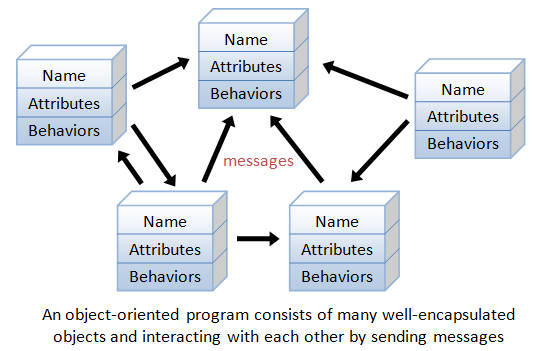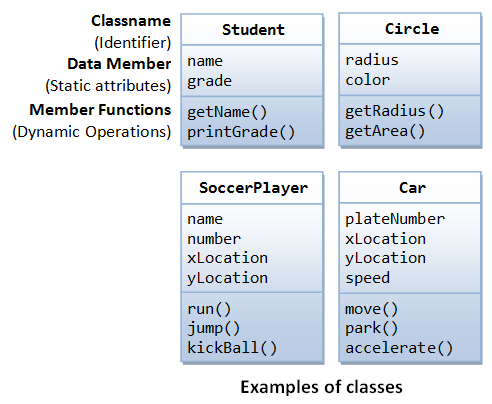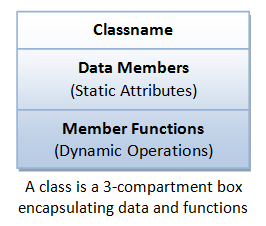C++ OOP
Agenda
- Theory
- Classes and Objects
- Inheritance
- Overloading
- Interfaces
Theory
The basic unit of OOP is a class, which encapsulates both the static attributes and dynamic behaviors within a "box", and specifies the public interface for using these boxes. Since the class is well-encapsulated (compared with the function), it is easier to reuse these classes. In other words, OOP combines the data structures and algorithms of a software entity inside the same box.
OOP languages permit higher level of abstraction for solving real-life problems. The traditional procedural language (such as C and Pascal) forces you to think in terms of the structure of the computer (e.g. memory bits and bytes, array, decision, loop) rather than thinking in terms of the problem you are trying to solve. The OOP languages (such as Java, C++, C#) let you think in the problem space, and use software objects to represent and abstract entities of the problem space to solve the problem.

Benefits of OOP
The procedural-oriented languages focus on procedures, with function as the basic unit. You need to first figure out all the functions and then think about how to represent data.
The object-oriented languages focus on components that the user perceives, with objects as the basic unit. You figure out all the objects by putting all the data and operations that describe the user's interaction with the data.
Object-Oriented technology has many benefits:
- Ease in software design as you could think in the problem space rather than the machine's bits and bytes. You are dealing with high-level concepts and abstractions. Ease in design leads to more productive software development.
- Ease in software maintenance: object-oriented software are easier to understand, therefore easier to test, debug, and maintain.
- Reusable software: you don't need to keep re-inventing the wheels and re-write the same functions for different situations. The fastest and safest way of developing a new application is to reuse existing codes - fully tested and proven codes.
OOP Basics
Class: A class is a definition of objects of the same kind. In other words, a class is a blueprint, template, or prototype that defines and describes the static attributes and dynamic behaviors common to all objects of the same kind.
Instance: An instance is a realization of a particular item of a class. In other words, an instance is an instantiation of a class. All the instances of a class have similar properties, as described in the class definition. For example, you can define a class called "Student" and create three instances of the class "Student" for "Peter", "Paul" and "Pauline".
The term "object" usually refers to instance. But it is often used quite loosely, which may refer to a class or an instance.
A Class is a 3-Compartment Box encapsulating Data and Functions.


Classes and Objects
Class
When you define a class, you define a blueprint for an object. This doesn't actually define any data, but it does define what the class name means, that is, what an object of the class will consist of and what operations can be performed on such an object.
Object
This is the basic unit of object oriented programming. That is both data and function that operate on data are bundled as a unit called as object.
class Box {
public:
double length; // Length of a box
double breadth; // Breadth of a box
double height; // Height of a box
};Inheritance
One of the most useful aspects of object-oriented programming is code reusability. As the name suggests Inheritance is the process of forming a new class from an existing class that is from the existing class called as base class, new class is formed called as derived class.
This is a very important concept of object-oriented programming since this feature helps to reduce the code size.
// Base class
class Shape {
public:
void setWidth(int w) {
width = w;
}
void setHeight(int h) {
height = h;
}
protected:
int width;
int height;
};
// Derived class
class Rectangle: public Shape {
public:
int getArea() {
return (width * height);
}
};Overloading
The concept of overloading is also a branch of polymorphism. When the exiting operator or function is made to operate on new data type, it is said to be overloaded.
class printData {
public:
void print(int i) {
cout << "Printing int: " << i << endl;
}
void print(double f) {
cout << "Printing float: " << f << endl;
}
void print(char* c) {
cout << "Printing character: " << c << endl;
}
};Polymorphism
The word polymorphism means having many forms. Typically, polymorphism occurs when there is a hierarchy of classes and they are related by inheritance.
C++ polymorphism means that a call to a member function will cause a different function to be executed depending on the type of object that invokes the function.
Consider the following example where a base class has been derived by other two classes:
class Shape {
protected:
int width, height;
public:
Shape( int a = 0, int b = 0) {
width = a;
height = b;
}
int area() {
cout << "Parent class area :" <<endl;
return 0;
}
};
class Rectangle: public Shape {
public:
Rectangle( int a = 0, int b = 0):Shape(a, b) { }
int area () {
cout << "Rectangle class area :" <<endl;
return (width * height);
}
};
class Triangle: public Shape{
public:
Triangle( int a = 0, int b = 0):Shape(a, b) { }
int area () {
cout << "Triangle class area :" <<endl;
return (width * height / 2);
}
};Interfaces
An interface describes the behavior or capabilities of a C++ class without committing to a particular implementation of that class.
The C++ interfaces are implemented using abstract classes and these abstract classes should not be confused with data abstraction which is a concept of keeping implementation details separate from associated data.
A class is made abstract by declaring at least one of its functions as pure virtual function. A pure virtual function is specified by placing "= 0" in its declaration as follows:
class Box {
public:
// pure virtual function
virtual double getVolume() = 0;
private:
double length; // Length of a box
double breadth; // Breadth of a box
double height; // Height of a box
};